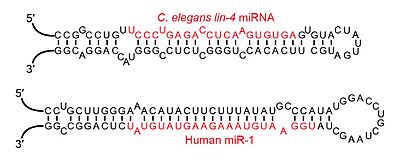- This page was last modified on 15 April 2025, at 02:15. Suggest an edit.
microRNA facts for kids
Not to be confused with mitochondrial DNA (m(t)DNA); or messenger RNA (mRNA).

Pre-miRNA instead of Pri-miRNA in the first point of mechanism. Diagram of microRNA (miRNA) action with mRNA
microRNA (miRNA, µRNA) are small, single-stranded, non-coding RNA molecules containing 21–23 nucleotides. Found in plants, animals, and even some viruses, miRNAs are involved in RNA silencing and post-transcriptional regulation of gene expression. miRNAs base-pair to complementary sequences in mRNA molecules, then silence said mRNA molecules by one or more of the following processes:
- Cleaving the mRNA strand into two pieces.
- Destabilizing the mRNA by shortening its poly(A) tail.
- Reducing translation of the mRNA into proteins.
In cells of humans and other animals, miRNAs primarily act by destabilizing the mRNA.
miRNAs resemble the small interfering RNAs (siRNAs) of the RNA interference (RNAi) pathway, except miRNAs derive from regions of RNA transcripts that fold back on themselves to form short hairpins, whereas siRNAs derive from longer regions of double-stranded RNA. The human genome may encode over 1900 miRNAs, However, only about 500 human miRNAs represent bona fide miRNAs in the manually curated miRNA gene database MirGeneDB.
miRNAs are abundant in many mammalian cell types. They appear to target about 60% of the genes of humans and other mammals. Many miRNAs are evolutionarily conserved, which implies that they have important biological functions. For example, 90 families of miRNAs have been conserved since at least the common ancestor of mammals and fish, and most of these conserved miRNAs have important functions, as shown by studies in which genes for one or more members of a family have been knocked out in mice.
miRNA and its role in post-transcriptional gene regulation was discovered in the early 1990s by the American scientists Victor Ambros and Gary Ruvkun, who received the 2024 Nobel Prize in Physiology or Medicine for their discoveries.
History
The first miRNA was discovered in the early 1990s. However, they were not recognized as a distinct class of biological regulators until the early 2000s. Research revealed different sets of miRNAs expressed in different cell types and tissues and multiple roles for miRNAs in plant and animal development and in many other biological processes. Aberrant miRNA expression are implicated in disease states. MiRNA-based therapies are under investigation.
The first miRNA was discovered in 1993 by a group led by Victor Ambros and including Lee and Feinbaum. However, additional insight into its mode of action required simultaneously published work by Gary Ruvkun's team, including Wightman and Ha. These groups published back-to-back papers on the lin-4 gene, which was known to control the timing of C. elegans larval development by repressing the lin-14 gene. When Lee et al. isolated the lin-4 miRNA, they found that instead of producing an mRNA encoding a protein, it produced short non-coding RNAs, one of which was a ~22-nucleotide RNA that contained sequences partially complementary to multiple sequences in the 3' UTR of the lin-14 mRNA. This complementarity was proposed to inhibit the translation of the lin-14 mRNA into the LIN-14 protein. At the time, the lin-4 small RNA was thought to be a nematode idiosyncrasy.
In 2000, a second small RNA was characterized: let-7 RNA, which represses lin-41 to promote a later developmental transition in C. elegans. The let-7 RNA was found to be conserved in many species, leading to the suggestion that let-7 RNA and additional "small temporal RNAs" might regulate the timing of development in diverse animals, including humans.
A year later, the lin-4 and let-7 RNAs were found to be part of a large class of small RNAs present in C. elegans, Drosophila and human cells. The many RNAs of this class resembled the lin-4 and let-7 RNAs, except their expression patterns were usually inconsistent with a role in regulating the timing of development. This suggested that most might function in other types of regulatory pathways. At this point, researchers started using the term "microRNA" to refer to this class of small regulatory RNAs.
The first human disease associated with deregulation of miRNAs was chronic lymphocytic leukemia. In this disorder, the miRNAs have a dual role working as both tumor suppressors and oncogenes.
See also
 In Spanish: Micro-ARN para niños
In Spanish: Micro-ARN para niños
- Anti-miRNA oligonucleotides
- C19MC miRNA cluster
- Gene expression
- List of miRNA gene prediction tools
- List of miRNA target prediction tools
- MicroDNA
- MicroRNA Biosensors
- MiRNEST
- MIR222
- miR-324-5p
- Mir-M7 microRNA precursor family
- RNA interference
- Small interfering RNA
- Small nucleolar RNA-derived microRNA

